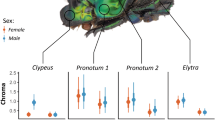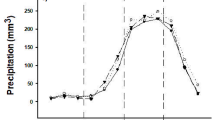Abstract
Selection for signal efficacy (detectability) is an important factor driving the evolution of chromatic signals. Communication theory predicts that colour signals should evolve to show those properties that maximize their conspicuousness to receivers in their own visual environment. In the ventrally polymorphic lizard Podarcis muralis, visual modelling has shown morph-specific differences in chromatic conspicuousness (orange > yellow > white). Although this suggests that morphs may incur different detectability costs, the differences in conspicuousness could be compensated behaviourally if individuals of the more conspicuous morphs adopted postures that made their colour patches less visible. We quantified the degree of exposure of the lizard ventral and ventrolateral coloration in the field to investigate the relationship between body posture and colour morph. We used a classification based on four lizard postures, from ventral surface completely hidden to full exposure of the ventral and ventrolateral colour patches (when lizards extend their forelegs and raise the head). As these postures may have consequences for thermoregulation, we also recorded substrate and lizard body temperatures using a thermographic camera. Results did not reveal differences among morphs in the frequency with which they adopt postures that expose their colour patches. In contrast, we found a strong relationship between body temperature and lizard posture. Overall, our results support the view that, regardless of colour morph, perching wall lizards adopt the elevated postures that maximize exposure of their ventral colour patches only when their body temperature is high enough to allow for an efficient predator avoidance response.
Significance statement
Selection for effective communication favours flashy, highly conspicuous coloration, but conspicuousness also makes colour signals more detectable to unintended receivers (e.g. predators). Some animals offset the costs associated with conspicuous coloration by evolving compensatory traits. In the lizard P. muralis, ventral colour morphs differ in conspicuousness and we hypothesized that the most conspicuous morphs might compensate for their increased conspicuousness by adopting postures that minimize exposure of their conspicuous colour patches. Results show that the morph-specific differences in conspicuousness are not compensated behaviourally. In contrast, we found a strong relationship between body temperature and lizard posture, suggesting that lizards, regardless of colour morph, adopt postures exposing their conspicuous colour patches only when their body temperature allows for an efficient predator avoidance response.




Similar content being viewed by others
References
Avery RA (1991) Temporal dynamics of a vigilance posture in the ruin lizards Podarcis sicula. Amphibia-Reptilia 12:352–356
Bartholomew GA (1966) A field study of temperature relations in the Galapagos marine iguana. Copeia 1966:241–250
Bauwens D, Garland T Jr, Castilla AM, Van Damme R (1995) Evolution of sprint speed in lacertid lizards: morphological, physiological, and behavioral covariation. Evolution 49:848–863
Bauwens D, Castilla AM, Mouton PFN (1999) Field body temperatures, activity levels and opportunities for thermoregulation in an extreme microhabitat specialist, the girdled lizard Cordylus macropholis. J Zool 249:11–18
Belliure J, Carrascal LM (2002) Influence of heat transmission mode on heating rates and on the selection of patches for heating in a Mediterranean lizard. Physiol Biochem Zool 75:369376
Braña F (1991) Summer activity patterns and thermoregulation in the wall lizard Podarcis muralis. Herpetol J 1:544–549
Brattstrom BH (1971) Social and thermoregulatory behavior of the bearded dragon, Amphibolurus barbatus. Copeia 1971:484–497
Caetano MH, Castanet J, Crespo EG (1986) Estimation à l’aide de la squelettochronologie de l’âge de Podarcis hispanica, (Steindacher, 1870), Sauria, Lacertidae, provenant d’une population portugaise. Rev Suisse Zool 93:117–127
Carretero MA (2008) How rigid are preferred temperatures in lacertids? An evolutionary survey in Podarcis, 6th Symposium on the Lacertids of the Mediterranean Basin. Abstract book, Mythimna, Lesvos (Greece), p 25, 23-27 June 2008
Carretero MA, Vasconcelos R, Fonseca M, Kaliontzopoulou A, Brito JC, Harris DJ, Perera A (2006) Escape tactics of two syntopic forms of the Lacerta perspicillata complex with different colour patterns. Can J Zool 84:1594–1603
Castilla AM, Van Damme R, Bauwens D (1999) Field body temperatures, mechanisms of thermoregulation and evolution of thermal characteristics in lacertid lizards. Nat Croat 8:253–274
Cooper WE Jr, Greenberg N (1992) Reptilian coloration and behavior. In: Gans C, Crews D (eds) Biology of the Reptilia, vol 18, Physiology. University of Chicago Press, Chicago, pp 298–422
Forsman A, Appelqvist S (1999) Experimental manipulation reveals differential effects of colour pattern on survival in male and female grasshoppers. J Evol Biol 12:391–401
Greenberg N (1976) Thermoregulatory aspects of behavior in the blue spiny lizard Sceloporus cyanogenys (Sauria, Iguanidae). Behaviour 59:1–21
Hedrick AV (2000) Crickets with extravagant mating songs compensate for predation risk with extra caution. Proc R Soc Lond B 267:671–675
Hensley NM, Drury JP, Garland T, Blumstein DT (2015) Vivid birds do not initiate flight sooner despite their potential conspicuousness. Curr Zool 61:773–780
Hertz PE, Huey RB, Nevo E (1982) Fight versus flight: body temperature influences defensive responses of lizards. Anim Behav 30:676–679
Hertz PE, Huey RB, Stevenson RD (1993) Evaluating temperature regulation by field-active ectotherms: the fallacy of the inappropriate question. Am Nat 142:796–818
Huey RB (1982) Temperature, physiology, and the ecology of reptiles. In: Gans C, Pough FH (eds) Biology of the Reptilia, vol 12, Physiology C. Physiological ecology. Academic Press, NY, pp 25–91
Husak JF, Lailvaux SP (2014) An evolutionary perspective on conflict and compensation in physiological and functional traits. Curr Zool 60:755–767
Husak JF, Swallow JG (2011) Compensatory traits and the evolution of male ornaments. Behaviour 148:1–29
Husak JF, Macedonia JM, Fox SF, Sauceda RC (2006) Predation cost of conspicuous male coloration in collared lizards (Crotaphytus collaris): an experimental test using clay‐covered model lizards. Ethology 112:572–580
Husak JF, Henningsen JP, Vanhooydonck B, Irschick DJ (2015) A performance-based approach to studying costs of reliable signals. In: Irschick DJ, Briffa M, Podos J (eds) Animal signaling and function: an integrative approach. Wiley, Hoboken, NJ, pp 47–74
Journey L, Drury JP, Haymer M, Rose K, Blumstein DT (2013) Vivid birds respond more to acoustic signals of predators. Behav Ecol Sociobiol 67:1285–1293
Kwiatkowski MA, Guyer C (2003) Variation in conspicuousness among populations of an iguanid lizard, Sauromalus obesus. Copeia 2003:481–492
Lattanzio MS, Metro KJ, Miles DB (2014) Preference for male traits differ in two female morphs of the tree lizard, Urosaurus ornatus. PLoS One 9, e101515
Lazić MM, Carretero MA, Mihailov-Krstev T, Lazarević-Macanović M, Krstić N, Crnobrnja-Isailović J (2012) Incidence patterns of ectodermal lesions in wild populations of Common wall lizard (Podarcis muralis). Amphibia-Reptilia 33:327–336
Luna S, Pérez i de Lanuza G, Font E (2013) Use of an infrared thermographic camera to measure field body temperatures of small lacertid lizards. Herpetol Rev 44:59–62
Macedonia JM, Brandt Y, Clark DL (2002) Sexual dichromatism and differential conspicuousness of the common collared lizard (Crotaphytus collaris) from Utah and New Mexico, USA. Biol J Linn Soc 77:67–85
Marshall KLA, Philpot KE, Stevens M (2015) Conspicuous male coloration impairs survival against avian predators in Aegean wall lizards, Podarcis erhardii. Ecol Evol 5:4115–4131
Martín-Vallejo J, García-Fernández J, Pérez-Mellado V, Vicente-Villardón JL (1995) Habitat selection and thermal ecology of the sympatric lizards Podarcis muralis and Podarcis hispanica in a mountain region of Central Spain. Herpetol J 5:181–188
Medel RG, Jimenez JE, Fox SF, Jaksic FM (1988) Experimental evidence that high population frequencies of lizard tail autotomy indicate inefficient predation. Oikos 53:321–324
Muth A (1977) Thermoregulatory postures and orientation to the sun: a mechanistic evaluation for the zebra-tailed lizard, Callisaurus draconoides. Copeia 1977:710–720
Nakagawa S, Cuthill IC (2007) Effect size, confidence interval and statistical significance: a practical guide for biologists. Biol Rev 82:591–605
Norris KS (1967) Color adaptation in desert reptiles and its thermal relationships. In: Milstead WW (ed) Lizard ecology: a symposium. University of Missouri Press, Columbia, pp 163–229
Olsson M, Stuart-Fox D, Ballena C (2013) Genetics and evolution of colour patterns in reptiles. Semin Cell Dev Biol 24:529–541
Oufiero CE, Garland T Jr (2007) Evaluating performance costs of sexually selected traits. Funct Ecol 21:676–689
Pérez i de Lanuza G, Font E (2015) Differences in conspicuousness between alternative color morphs in a polychromatic lizard. Behav Ecol 26:1432–1446
Pérez i de Lanuza G, Font E, Carazo P (2013) Colour assortative mating in a colour polymorphic lacertid lizard. Behav Ecol 24:273–279
Pérez i de Lanuza G, Carazo P, Font E (2014) Colours of quality: structural (but not pigment) coloration informs about male quality in a polychromatic lizard. Anim Behav 90:73–81
Powell GL, Russell AP (1985) Field thermal ecology of the eastern short-homed lizard (Phrynosoma douglassi brevirostre) in southeastern Alberta. Can J Zool 63:228–238
Rand AS (1964) Inverse relationship between temperature and shyness in the lizard Anolis lineatopus. Ecology 45:863–864
Sannolo M, Mangiacotti M, Sacchi R, Scali S (2014) Keeping a cool mind: head-body temperature differences in the common wall lizard. J Zool 293:71–79
Sinervo B, Lively CM (1996) The rock-paper-scissors game and the evolution of alternative male reproductive strategies. Nature 380:240–243
Stuart-Fox D, Moussalli A (2009) Camouflage, communication and thermoregulation: lessons from colour changing organisms. Philos T Roy Soc B 364:463–470
Stuart‐Fox DM, Moussalli A, Marshall NJ, Owens IPF (2003) Conspicuous males suffer higher predation risk: visual modelling and experimental evidence from lizards. Anim Behav 66:541–550
Swallow JG, Hayes JP, Koteja P, Garland T Jr (2009) Selection experiments and experimental evolution of performance and physiology. In: Garland T Jr, Rose MR (eds) Experimental evolution: concepts, methods, and applications of selection experiments. University of California Press, California, pp 301–352
Teasdale LC, Stevens M, Stuart-Fox D (2013) Discrete colour polymorphism in the tawny dragon lizard (Ctenophorus decresii) and differences in signal conspicuousness among morphs. J Evol Biol 26:1035–1046
Tomkins JL, Kotiaho JS, Lebas NR (2005) Phenotypic plasticity in the developmental integration of morphological trade-offs and secondary sexual trait compensation. Proc R Soc Lond B 272:543–551
Tuttle MD, Taft LK, Ryan MJ (1982) Evasive behaviour of a frog in response to bat predation. Anim Behav 30:393–397
Vercken E, Massot M, Sinervo B, Clobert J (2007) Colour variation and alternative reproductive strategies in females of the common lizard Lacerta vivipara. J Evol Biol 20:221–232
Acknowledgments
The study was supported by FEDER through the COMPETE program (ref. 008929) and Portuguese national funds through the FCT (Fundação para a Ciência e a Tecnologia, Portugal) project PTDC/BIA-BEC/101256/2008 and a grant (CGL2011-23751) from the Spanish Ministerio de Ciencia e Innovación. GPL was supported by post-doctoral grant (SFRH/BPD/94582/2013) from FCT under the Programa Operacional Potencial Humano–Quadro de Referência Estratégico Nacional funds from the European Social Fund and Portuguese Ministério da Educação e Ciência. We thank the editor and two anonymous reviewers for their valuable comments.
Author information
Authors and Affiliations
Corresponding author
Ethics declarations
An attempt was made to minimize lizard disturbance during observations. At worst, lizards avoided the observer by moving away. No lizards were captured or manipulated during the observations. The habitat (i.e. rocks, vegetation) was not altered in any way. Field work was performed under research permit number 2013095-0001 issued by the Préfecture des Pyrénées-Orientales (France). This research complied with the ASAB/ABS Guidelines for the Use of Animals in Research.
Additional information
Communicated by T. Madsen
Electronic supplementary material
Below is the link to the electronic supplementary material.
ESM 1
(PDF 251 kb)
Rights and permissions
About this article
Cite this article
Pérez i de Lanuza, G., Carretero, M.Á. & Font, E. Thermal dependence of signalling: do polymorphic wall lizards compensate for morph-specific differences in conspicuousness?. Behav Ecol Sociobiol 70, 1151–1159 (2016). https://doi.org/10.1007/s00265-016-2123-1
Received:
Revised:
Accepted:
Published:
Issue Date:
DOI: https://doi.org/10.1007/s00265-016-2123-1




